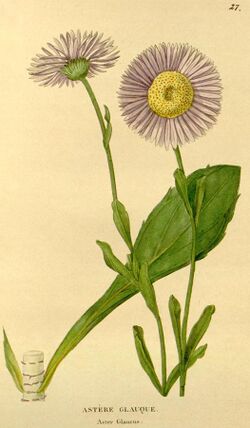Biology:Eurybia glauca
| Eurybia glauca | |
|---|---|

| |
| Eurybia glauca as Aster Glaucus | |
| Scientific classification | |
| Kingdom: | Plantae |
| Clade: | Tracheophytes |
| Clade: | Angiosperms |
| Clade: | Eudicots |
| Clade: | Asterids |
| Order: | Asterales |
| Family: | Asteraceae |
| Genus: | Eurybia |
| Species: | E. glauca
|
| Binomial name | |
| Eurybia glauca (Nutt.) G.L.Nesom
| |
| Varieties[1] | |
| |
| Synonyms[1] | |
| |
Eurybia glauca is a North American species of flowering plants in the family Asteraceae, called the gray aster. It is native to the western United States, primarily in Arizona, New Mexico, Utah, Colorado, and Wyoming, with a few populations in Idaho and Montana.
Eurybia glauca is a perennial herb or subshrub up to 70 centimeters (28 inches) tall from a woody rhizome. The plant produces flower heads numerous heads (sometimes over 100) in a flat-topped array. Each head contains 8-19 lavender ray florets surrounding 12-32 yellow or purplish disc florets.[2]
Taxonomy
Eurybia glauca was first described and given its first name as Eucephalus glaucus by the famous botanist Thomas Nuttall.[1] He described it in a paper read to the society on 2 October 1840, but published in 1841 in Transactions of the American Philosophical Society. It was given a brief description and noted as growing, "Towards the sources of the Platte, and in the Rocky Mountains."[3] In 2004 Luc Brouillet published a paper arguing for its reclassification as Herrickia glauca along with a general reorganization of species into a restored genus, Herrickia.[4] However, as of 2023 Plants of the World Online (POWO) accepts the 1995 description by Guy L. Nesom as Eurybia glauca.[1]
Range
Eurybia glauca primarily grows west of the Rocky Mountains in Colorado, northern New Mexico, Arizona, and Utah. It also is found through much of Wyoming with a population known from one county in Idaho and other small populations in Montana.[5][6][7]
References
- ↑ 1.0 1.1 1.2 1.3 "Eurybia glauca (Nutt.) G.L.Nesom" (in en). Royal Botanic Gardens, Kew. http://www.plantsoftheworldonline.org/taxon/981729-1.
- ↑ Flora of North America, Herrickia glauca (Nuttall) Brouillet, 2004. Gray aster
- ↑ Nuttall, Thomas (1841). "Article XX. - Descriptions of new Species and Genera of Plants in the natural Order of the Composit, collected in a Tour across the Continent to the Pacific, a Residence an Oregon, and a Visit to the Sandwich Islands and Upper California, during the Years 1834 and 1835" (in English). Transactions of the American Philosophical Society (American Philosophical Society) 7: 299. https://archive.org/details/sim_transactions-of-the-american-philosophical-society_1841_7_0/page/299. Retrieved 19 August 2023.
- ↑ Brouillet, Luc; Urbatsch, Lowell; Roberts, R. P. (2004). "Tonestus kingii and T. Aberrans are Related to Eurybia and the Machaerantherinae (Asteraceae: Astereae) Based on nrDNA (ITS and ETS) Data: Reinstatement of Herrickia and a New Genus, Triniteurybia". SIDA, Contributions to Botany 21: 897. ISSN 0036-1488. https://www.biodivershttps://www.biodiversitylibrary.org/page/9311119#page/917tylibrary.org/part/163646. Retrieved 19 August 2023.
- ↑ Biota of North America Program 2014 county distribution map, Herrickia glauca
- ↑ Nesom, G. L. (2009). Taxonomic overview of Eurybia sect. Herrickia (Asteraceae: Astereae). Journal of the Botanical Research Institute of Texas 3(1): 161–167. includes distribution map on page 164, as Eurybia glauca
- ↑ Template:Cite usda plants
Wikidata ☰ {{{from}}} entry
 |

